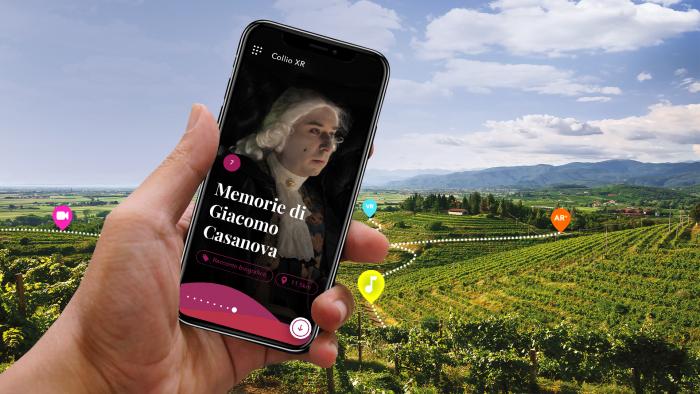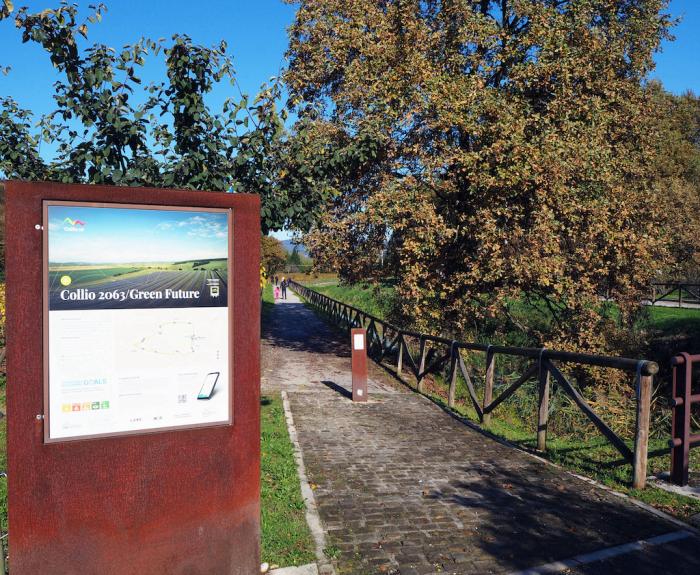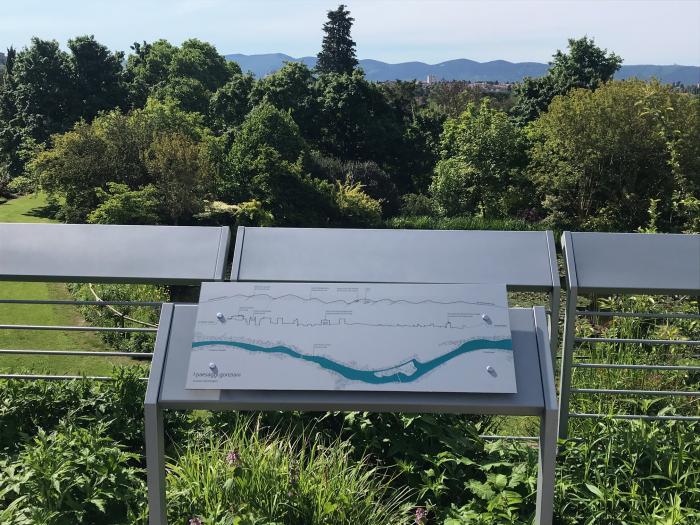I. SUMMARY INFORMATION
Project
267930
Status
Submitted
Award category
Preserved and transformed cultural heritage
You want to submit
NEW EUROPEAN BAUHAUS AWARDS : existing completed examples
Project title
CariGO GREEN3
Full project title
CariGO GREEN3: where technology meets landscape and people.
Description
Remembrance is necessary, even when it’s painful. A hundred years ago, the First World War devastated cities and landscapes – and people’s souls. As it did the Karst Plateau, a historically important area between Italy and Slovenia. The CariGO GREEN3 project reveals history, culture and future of the landscape in an immersive digital storytelling which aims to promote more sustainable tourism patterns and attract massive seaside tourism of the region to experience the hinterland's heritage.
Where was your project implemented in the EU?
Italy
Friuli Venezia Giulia
VIA CARDUCCI, 2
GORIZIA
34170
When was your project implemented?
Has your project benefited from EU programmes or funds?
Yes
Which programme(s) or fund(s)? Provide the name of the programme(s)/fund(s), the strand/action line as relevant and the year.
Yes, part of the project (year 2018) was labeled by “The European Year of Cultural Heritage 2018”
II. DESCRIPTION OF THE PROJECT
Please provide a summary of your project
CariGO GREEN3 is a territorial development programme of the Gorizia Landscape in the Italian Friuli Venezia Giulia region on the border to Slovenia. The Fondazione Cassa di risparmio di Gorizia is a non-profit organisation working to promote social and economic development in the province of Gorizia and understood the importance of taking responsibility to develop their hosting territory - acting as catalyst to promote a network of targeted interventions. To build a connected, innovative and green territory they teamed up with the landscape architecture studio LAND and the digital farm IKON. Based on territorial masterplan "Carso 2014+", developed for the Gorizia Province in 2007, they launched the 3 year programme (2018-2020) of CariGO GREEN3, to become greener in three years but with an exponential long-term positive effect for the local heritage, tourism and local development. The programme consists of three projects which create a productive landscape which enables the visitor to discover the culture of Gorizia throughout the territory, accompanied by free, tailored technology, free of charge. The projects work only with existing infrastructures such as buildings and pathways and provide a completely new experience of the area without carbon footprint. The program gave highest attention to the historical heritage and a sustainable economy and developed an infrastructure of museum/garden, trekking paths and bicycle routes linked with a free smartphone app that provides a digital storytelling experience: audio and video narratives, virtual and augmented reality, related to the territory and explaining the UN SDG links. The integrated ecosystem of nature, infrastructure and culture shows a common field of action for the public and private sector and is a successful strategy that can be transferred to any other cultural territory that struggles with postpandemic tourism opportunities, loss of commemorative culture and struggling rural agricultural environments.
Please give information about the key objectives of your project in terms of sustainability and how these have been met
In line with the aims formally set down by the EU Green Deal and by the subsequent Climate Law, the vision of the LAND strategy for CariGO GREEN3 is that of a Productive Landscape: an integrated ecosystem of nature, infrastructures, cultural environments, and economic activities that networks the various sectors and local players in a context of active participation, enabling the individual elements to develop and favor each other reciprocally. All projects are designed to meet targets of the UN Sustainable Development Goals (SDGs) and to educate visitors about their importance (SDG13-3). The combination of different technologies, proposed by IKON, (SDG9) allows to digitalize new landscape aspects, such as its fragility or opportunities (SDG15-5,9), and recreate invisible, past aspects of the territory. It offers a respectful opportunity to discover the region with the digital free access to knowledge and entertainment (SDG11-3,4,7,11-A). The experience can be made with or without the digital aspect as all routes also provide information boards, they promote slow mobility and allow non-invasive recreation. The rural landscape transformation with minimal physical operations is eco-sustainable (SDG12) and strongly includes local players for active participation (SDG8). The development of this programme showed that the value of the territory is marked by its landscape and not by its border to Slovenia, all interventions can be adopted behind the border, processing and recognizing the history to learn from the past and find a common green vision for the future. The area of Collio, where the second project CollioXR was developed, is currently preparing the application as UNESCO world heritage together with the area Brda (SVN) which might have been discovered by the richly visited project of CollioXR.
Please give information about the key objectives of your project in terms of aesthetics and quality of experience beyond functionality and how these have been met
CariGO GREEN3 represents the paradigm change of knowledge transfer from a static building to a dynamic experience in the landscape. The first project-part, Carso, was developed in 2018 and consists of the museum of Monte San Michele, a renovated historical building which offers, besides the digital and physical information about the history, the present and the future of the territory, also the entrance to the landscape to experience and learn. Respecting the physical distancing, a free smartphone App accompanies the visitor through the hills of Collio XR and the river of Isonzo XR with an experimental and interactive guidance, including georeferenced storytelling, virtual contents in rest areas and many trekking routes that all touch individual topics, times, literary styles and SDGs with a high immersive narrative. Concepts of sustainability and insights on the transformation of the regional territory in the face of climate are combining memory with new technology. A particularly interesting aspect is the low to zero visual impact on the landscape and the redefinition of the existing without the need of new construction. Slow cycle and pedestrian connections allow the pleasure of safe and jaunty experience for people of all age and with different mobility capacities. The landscape is being discovered with new eyes throughout design, technology and an European point of view. On the other side of the territory there is the recently opened Viatori villa and garden which compliments the consortium of the CariGO GREEN3 project with the renovated property of Luciano Viatori giving a splendid view over the city of Gorizia with its castle, the Isonzo river, the Carso hill and the Pre-Alps. Its terraced garden offers the emotional experience about the natural diversity of the historical arrangement and the region, equally interactive and natural complemented. Moreover, the garden hosts the first of 5 paths from Gorizia to the Adriatic see along the Isonzo river.
Please give information about the key objectives of your project in terms of inclusion and how these have been met
All projects have a particular focus on the importance of slow mobility to create a safe space for careless discovery of the area. An interesting aspect is, that thanks to the smartphone applications they provide a digital inclusion as you can access the stories, the knowledge, and the tours digitally from anywhere in the world. During and after the implementation of the project, local players like winemakers, mayors and schools actively participated and enriched the interactive and experimental approach. Like this, touristic and productive realities became a relevant part of the experience for visitors and resulted in an innovative way to live the territory and attract visitors and the opportunity to reflect the past, present and future if its inhabitants. The strengthened interaction and collaboration with the users led to an active protection of the fundamental elements of the landscape and its monitoring and management, like for example a voluntary cooperative in Monte San Michele that was created thanks to the CariGO GREEN3 project and takes care about the surrounding landscape. And the rich offered content is just the beginning: other stories such as those of witnesses of earlier time periods or people’s visions for the sustainable future of this territory can be implemented in the canvas of the applications and the route network, it is an open system of storytelling.
The natural hydrographic system and the number of artificial channels that generate the geometric grid of the fields have contributed to the transformation of the landscape. This deep fusion between nature and human intervention has shaped the area, becoming a key element for its future evolutions. In this context, the main challenges concerning the area stand out: in collaboration with the users, they actively protect the fundamental elements of the landscape, their monitoring and their management.
Please give information on the results/impacts achieved by your project in relation to the category you apply for
The project managed the integration of nature, infrastructure, culture and economy within one strategy and in each of its project parts due to the created naturalistic, cultural and historical connection within and with the surrounding. The contemporary presentation helped the healing of historical wounds in landscape by landscape. The project empowered the local recuperation of the WWI history and agronomical culture and made the invisible visible as trenches could once again be revealed, observation decks installed, and paths created. The relationship with the territory got intensified by the digital landscape model and recreational activities about productive realities. Today, the candidature as UNESCO world heritage is underway as Slovenian-Italian joint application and despite the many conflicts of the past, the Friulians were able to rediscover its collective landscape. The decision to complete thematic routes of tourism and cultural interest through digital creates a system of points of interchange, the natural mountain heritage of the Slovenian area, the lagoon area of the Italian outlet, the rural areas, places of historical interest and a multifunctional Hub.
Please explain the way citizens benefiting from or affected by the project and civil society have been involved in the project and what has been the impact of this involvement on the project
The enhancement of profitable tourism and the reinforcement of productive land were key drivers in the project development. Therefore, local stakeholders, schools, private and public organizations were included in the entire process. Within the project part of Carso, there were 3 official events held in 2018, including a conference with agricultural businesses in Sagrado, the museum opening ceremony with a public group hike on Monte San Michele and a project presentation in Brussels at the Friuli Venezia Giulia Delegation to the EU with the title "The future is in the countryside. A territorial revitalization project". In 2019 there were two public conferences held in Cormons for the project launch and opening of CollioXR and after the launch conference 2020 in Staranzano, the opening event of the third project part IsonzoXR was publicly held in Gorizia at the Viatori Garden on April 21st 2021. Those events helped to receive direct feedback form the citizens and created trust by providing information on the processes and the goals. As the project provides free access to the content and the landscape is owned by the people anyways, there was high appreciation received for the cultural re-evaluation of their territory. The production of good practices in terms of environmental sustainability were stimulated and the social and economic development of the area was encouraged. The combination of those actions with the upgrade of stretches and areas of existing cycle paths, thus promoting the maintenance and revitalization of the infrastructure strengthened the identification and feeling of belonging to the locals. The driving sector is the agricultural one, in particular, the wine production is the most valuable. Users’ interest, together with landscape and wine, has contributed to relaunch the farms in the area and increase the visibility of this region.
Please highlight the innovative character of the project
A project that values the three areas Carso, Collio and Isonzo, that for the first time includes digital storytelling, captivating narrations telling of the territory, soundscapes, a narration through audio and video immersive contents, interactive maps with navigation and guide to the routes through interactive mapping, and virtual & augmented reality, with fully immersive videos and augmented 3D contents in the areas where you stop off. It is not only the latest technology that is implemented in an experimental, interactive and intuitive way but it is also the respectful development of a prototype paradigm approaching suburban territories that are struggling since decades all over Europe. It's a model to restart tourism in an innovative but non-invasive approach on different scales and in different disciplines. The consistency between the open-air museum, the digital VR museum and the garden is combining to crucial aspects of knowledge transfer in an emotional and inviting way. Through the use of innovative digital technologies Casa Viatori provides an innovative and interactive experience of its garden and its history. The lead through the widespread territory by georeferenced storytelling is bringing together existing technology and the minimal transformed landscape in a surprisingly satisfactory and novel way.
Please explain how the project led to results or learnings which could be transferred to other interested parties
The concept of smart combination of technology and territory can be applied elsewhere, adjusted at the complex constellations on site. The Application canvas is already developed and can be filled with any other content and linked to the referring landscape. The successful strategy of project design from a landscape point of view, working with the existing and respecting grown structures helps to provide a CO2 neutral or positive intervention. The project is thus configured as a tool to spread the knowledge of the inland places, to expand the fruition offer of an area characterized by great landscape qualities and important wine productions. It is a way of promoting active protection of the landscape, which can thus contribute to the socio-economic development of the area in a sustainable way.
This summer, the Fondazione Cassa di Risparmio di Gorizia (Fondazione CariGO) will release a publication about the natural, cultural and innovative sustainability in the territory of Isonzo river. Besides Andreas Kipar ("Cultivation of the future"), co-founder of the studio LAND, and Enrigo Degrassi ("Paessaggio XR"), co-founder of IKON, several professionals from the fields of ecology, journalism, urban studies and foundation's work will compose a Manifesto of the productive landscape that will give a broad overview on the acquired knowledge and the opportunities that lie in the rural areas of Europe.
Is an evaluation report or any relevant independent evaluation source available?
III. UPLOAD PICTURES
IV. VALIDATION
By ticking this box, you declare that all the information provided in this form is factually correct, that the proposed project has not been proposed for the Awards more than once under the same category and that it has not been subject to any type of investigation, which could lead to a financial correction because of irregularities or fraud.
Yes




